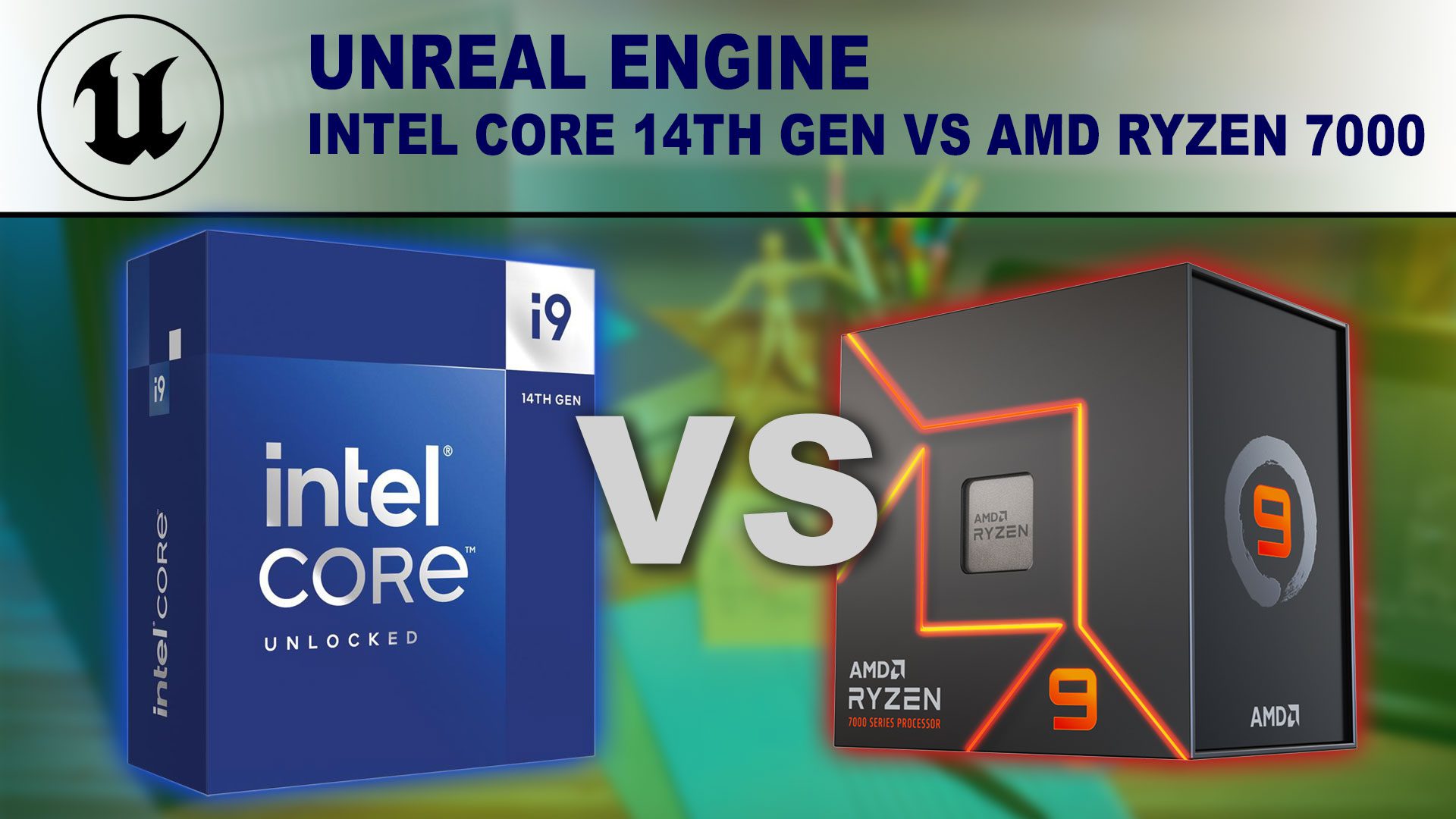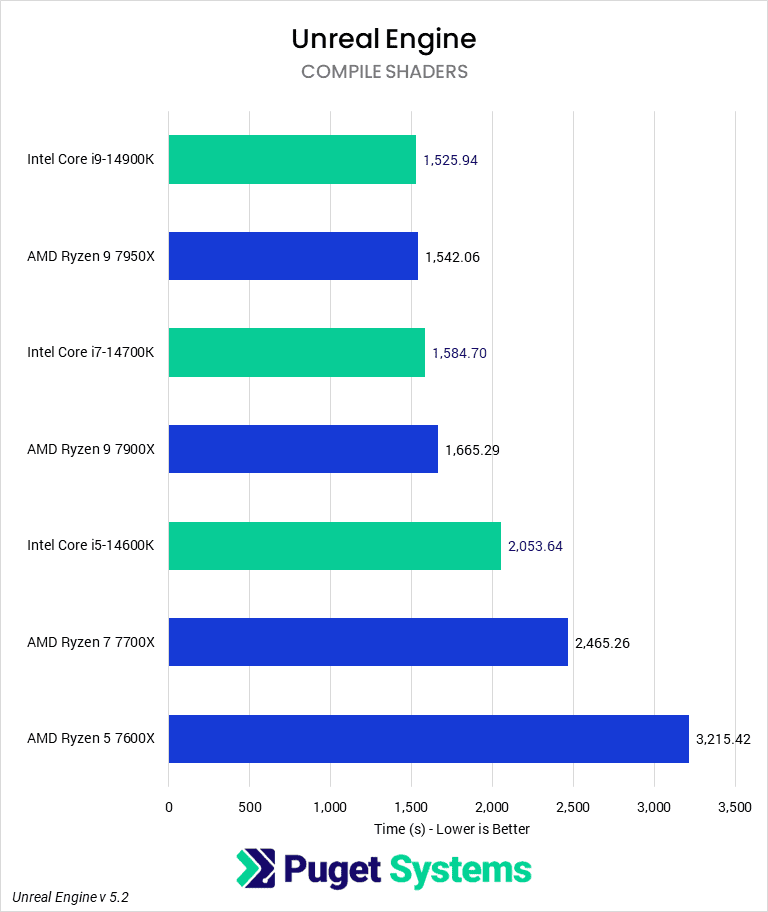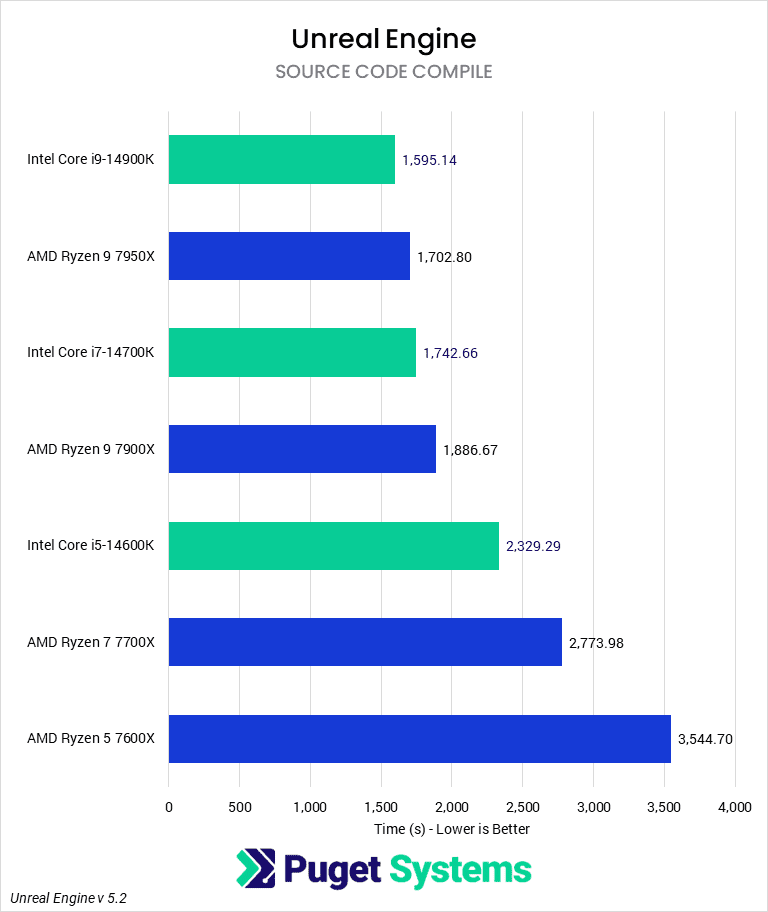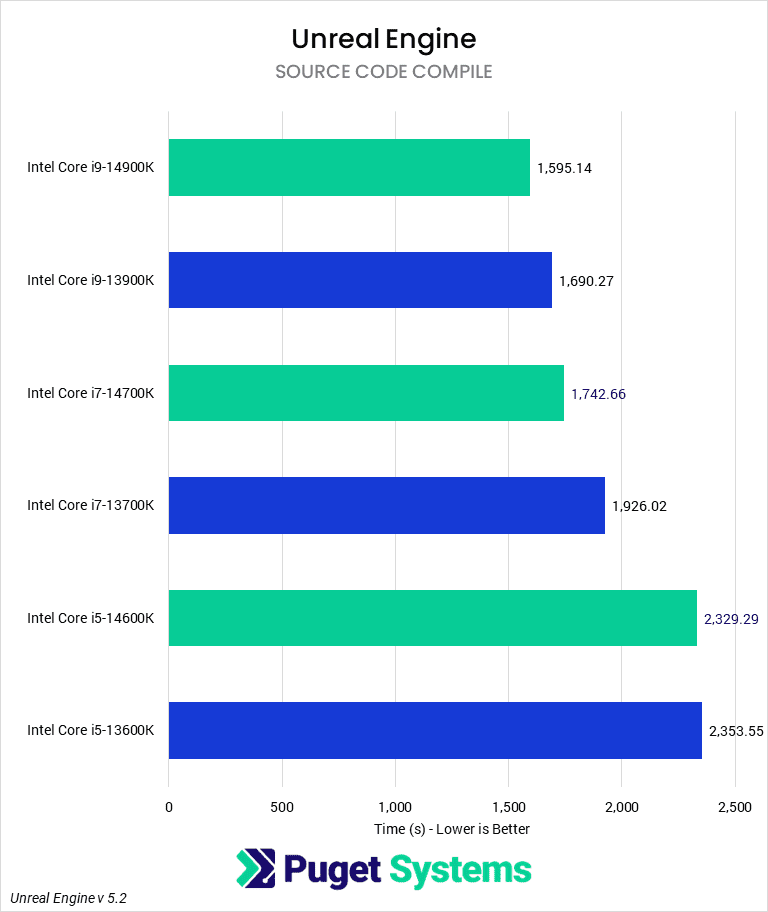Table of Contents
TL;DR: 14th Gen Intel performance in Unreal Engine
The 14th Gen Intel CPUs perform well in Unreal Engine compared to AMD’s 7000 series Ryzen CPUs. The flagship 14900K is virtually tied with the Ryzen 7950X yet costs much less. Meanwhile, the 14700K and 14600K hold strong leads over their competition, the 7700X and 7600X, respectively.
However, compared to the previous generation from Intel, there is little difference with these new CPUs, often as little as 1-2%. Only the 14700K sees double-digit performance gains thanks to the four extra “E”-cores it received.
Introduction
Last year, Intel launched its 13th Gen Core Processors codenamed Raptor Lake-S for desktop. These processors, a follow-up to their 12th Gen Alder Lake processors and using the same hybrid architecture of “P” (Performance) and “E” (Efficient) cores, supported DDR4 and DDR5 and were compatible with the same LGA 1700 socket while offering a 10-30% performance increase; the high end of this due to increases in “Efficiency core”-counts. Intel is now launching the next step up with their 14th Gen Intel Core Processors codenamed Raptor Lake-S Refresh. Like 13th Gen, these CPUs are drop-in compatible with LGA 1700 motherboards while offering higher frequencies and IPC improvements. The i7 variant—14700K—also features four additional “E”-cores over the 13700K.
Unreal Engine is a popular real-time 3D rendering engine that sees widespread use in game development, virtual production, and visualization. Most users of Unreal Engine will find that a graphics card has the largest impact on performance, but there are a number of CPU-bound tasks that are especially prevalent on the game development side, such as compiling source code or shaders. These are dependent almost wholly on multi-core CPU performance and, unlike many of our other CPU benchmarks, are sensitive not only to per-core performance but also memory latency and bandwidth and cache size and speed.

In this article, we will be using Unreal Engine to examine the performance of the new 14th Gen Intel Core Processors and compare them to the previous generation of Intel CPUs, as well as to AMD’s 7000 series of CPUs. The two areas we will look at that rely on CPU performance are compiling shaders in the engine, and compiling the source code in Visual Studio. Compiling shaders is something that every Unreal Engine user faces from time to time. For many, this is an occasional annoyance, while others, especially at larger game studios, will deal with this on a daily basis. Compiling the source code is usually only encountered by game developers who need to be able to customize the engine to their needs, or those looking for the most cutting-edge versions of Unreal before they hit the marketplace.
If you want to read more about the new Intel 14th Gen Core CPUs and what separates them from the previous generation, we recommend checking out our main 14th Gen Intel Core Processors Content Creation Review article. That post includes more detailed information on the CPU specifications and an overview of testing results for a range of other applications, including Photoshop, Lightroom Classic, Premiere Pro, DaVinci Resolve, After Effects, Cinema 4D, Blender, and V-Ray. Although these CPUs, like the previous generation, can draw a large amount of power, we are currently disabling any features that run the tested CPUs outside of manufacturer specifications. We are also running the CPUs at the “standard” power profiles, as this is how we currently ship out systems. For more information about the impact of the power profile and how larger coolers affect the performance of the CPUs, you can refer to our Power Draw and Cooling: 14th Gen Intel Core Processors article.
Intel Core 14th Gen vs AMD Ryzen 7000 for Unreal Engine
Comparing the new Intel 14900K to AMD’s Ryzen 7950X, we see a virtual tie in shader compiling. These two scores are within the margin of error for this test and could see either one take the top spot with changes to motherboards, RAM timing, BIOS update, etc. The source code compiling results shows that Intel takes a roughly 7% lead. This is a small lead, but keep in mind that the Intel CPU has a lower MSRP at the time of writing. The 14900K is much cheaper than the Ryzen 7900X, with a difference of only $40. Here, Intel leads by 8% in shader compiling times and 15% in source code compiling.
Moving on to the lower-end parts, the story changes, and Intel takes a strong lead. This says a lot about the performance of Intel’s parts and the amazing value they provide. The Intel Core I7 14700K offers more cores and threads than AMD’s Ryzen 7700X while only being $10 more expensive. This translates into a more than 40% lead in performance for Intel in both tests.
This massive performance lead is seen in the final CPU, the Intel Core i5 14600k. This CPU averages 40% faster than Ryzen 7600X. We do not recommend any CPU with eight or fewer cores, so Intel’s new 14600K provides a great entry-level CPU for Unreal development.
Intel Core 14th Gen VS Intel Core 13th Gen for Unreal Engine
In the previous section, we examined how the new 14th Gen Intel processors stack up against AMD’s newest Ryzen 7000, but we should also examine how they compare to the previous 13th Gen Intel CPUs. As we can see from the chart, the new CPUs don’t offer much improvement over the previous generation.
On the high end, the 14900K is only 1% faster than the 13900K in compiling shaders and 6% faster in code compiling. This result gives no reason to upgrade from 13900K to this new CPU.
The 14700K sees a bigger improvement due in part to the extra e-cores in this version. This CPU is 6% faster than the 13700 compiling shaders and 10% faster in compiling the source code in Visual Studio. While this is a better result than we saw with the 14900K, it is still not as much of an improvement as we would hope between generations and with the extra cores.
The lower-end 14600K also has an almost 1-2% improvement in both tests. This is pretty disappointing for a generational uplift. This CPU did much better in our CPU rendering tests, so we would have hoped to see similar improvements here.
How well do the Intel Core 14th Gen CPUs perform in Unreal Engine?
Intel’s new 14th Gen CPUs show modest improvements from 1-10% over the previous generation. While the new CPUs perform well compared to AMD’s lineup, they are less impressive compared to the previous CPUs from Intel. The 14900K’s less than 2% increase in shader compile times, arguably the most important metric for Unreal, is unimpressive. The 14600K performed nearly identical to its predecessor. Only the 14700K had a 10% improvement due to the extra cores it received. While these are good CPUs, they are not worth upgrading from the previous 13000 series.
Bear in mind that the benchmarks presented in this article are for Unreal Engine and that performance can vary dramatically between different applications; each software will utilize the available hardware differently and so be impacted in a unique way by hardware changes. If you use other software packages in your workflow, we recommend checking out our 14th Gen Intel Core Processors Content Creation Review article, which includes results and links to in-depth testing for a range of other applications, including Photoshop, Lightroom Classic, Premiere Pro, DaVinci Resolve, After Effects, Cinema 4D, Blender, and V-Ray.
Finding the perfect workstation doesn’t have to be complicated. Explore our solutions page for a curated selection of recommended systems for a multitude of applications and workflows, or visit our custom configuration page if you already know the ideal hardware for your needs. If you need assistance with tailoring a system to a unique workflow or have any other questions, we encourage you to reach out to our dedicated technology consultants.










